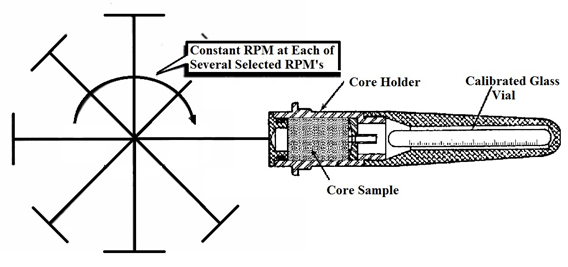Fundamentals of Fluid Flow in Porous Media
Chapter 2
Multi-phase Saturated Rock Properties:
Laboratory Measurement of Capillary Pressure: Centrifugal Method
In this method injection pressure (capillary pressure PC) applied through centrifugal force. The high acceleration in the centrifuge increases the field of force on the fluids, subjecting the core, in effect, to an increased gravitational force. In other words it relies upon increasing the ‘g’ term in the equation:

When the sample is rotated at various constant speeds, a complete capillary pressure curve can be obtained. The speed of rotation is converted to capillary pressure using the following equation:

Where:
- rb = radius of rotation of the bottom of core sample
- rt = radius of rotation of the top of the core sample
- ω = rotational speed
For the oil-water drainage cycle, water fully saturated core samples are immersed in oil in specially designed core holders. Starting at a low rpm setting, the amount of brine expelled from the plug is noted for a given rate of rotation. A calibrated glass vial is attached to the end of the sample. The volume of fluid being deposited in this vial can be read while the centrifuge is spinning fast. Thus, the saturation can be obtained. The rate is then increased in stages and produced water volumes are recorded for each rotation speed to give the drainage curve. The most important advantage of this method is its speed of obtaining data. A complete curve may be obtained in a few hours.

Figure 2-57: Centrifugal Apparatus
Questions?
If you have any questions at all, please feel free to ask PERM! We are here to help the community.
